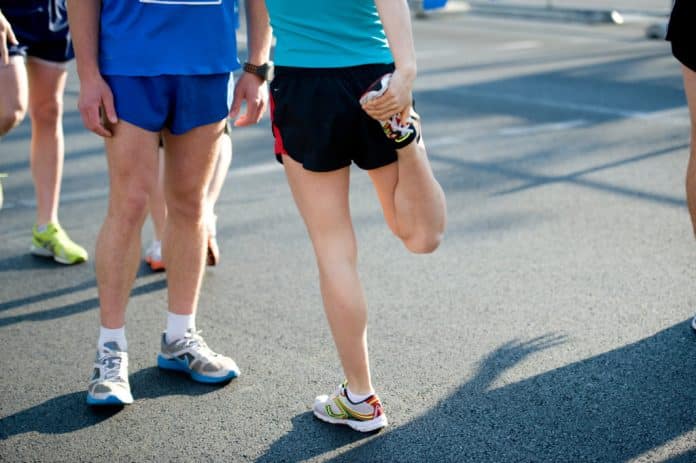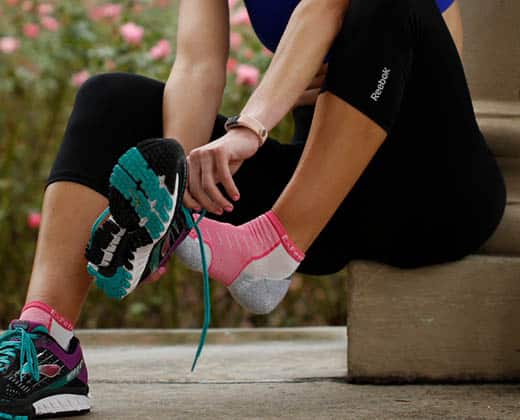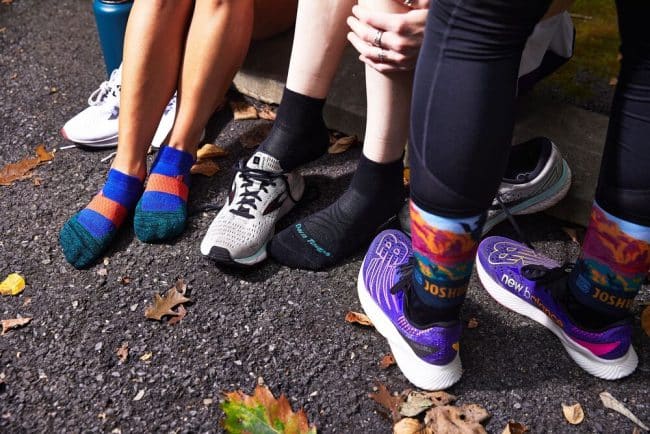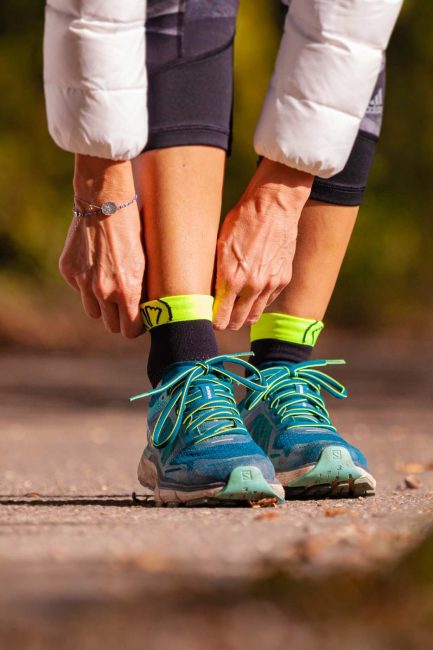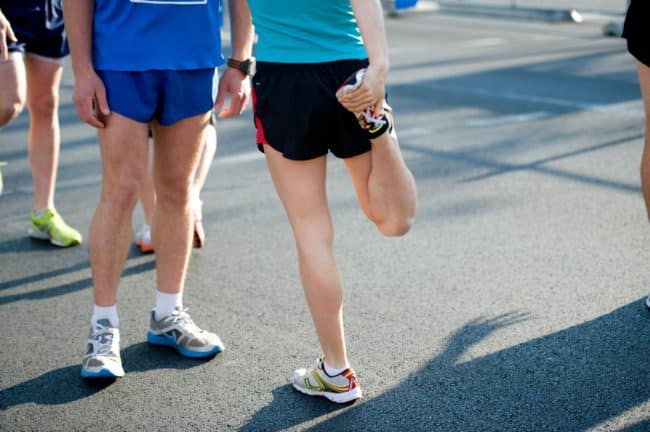Running socks may seem like an unnecessary accessory when it comes to hitting the pavement, but their benefits might surprise you. While it’s easy to overlook their importance, investing in a good pair of running socks can significantly enhance your overall running experience. From preventing blisters and hot spots to providing moisture-wicking properties, these specialized socks are designed to keep your feet comfortable and protected during those long, intense runs. So before you lace up your shoes for your next workout, let’s explore the reasons why running socks should not be overlooked in your running routine.
This image is property of cdn.runningshoesguru.com.
Review contents
Benefits of Running Socks
When it comes to running, the right gear can make a world of difference. While most runners instinctively focus on getting the right running shoes, many overlook the importance of choosing the proper running socks. Running socks offer a range of benefits that can significantly enhance your running experience.
Improved Comfort
One of the main advantages of running socks is the improved comfort they provide. Unlike regular socks, running socks are specifically designed to cater to the needs of runners. They have extra padding in key areas to absorb impact and cushion your feet during long runs. This added cushioning helps reduce discomfort and fatigue, allowing you to run for longer periods without discomfort.
Moisture Wicking
Another significant benefit of running socks is their moisture-wicking properties. When you’re running, your feet can quickly become sweaty, which can lead to blisters and discomfort. Running socks are made from moisture-wicking materials such as nylon, polyester, or merino wool, which help keep your feet dry. These materials pull moisture away from your skin and allow it to evaporate, keeping your feet cool and preventing blisters.
Reduced Friction
Friction can be a runner’s worst enemy. The repetitive motion of running can cause friction between your feet and your shoes, leading to blisters and hotspots. Running socks are designed to minimize friction by providing a smooth barrier between your feet and your shoes. Their seamless construction and snug fit help prevent rubbing, ensuring a more comfortable running experience.
Blister Prevention
Lastly, running socks are instrumental in blister prevention. The combination of moisture-wicking properties and reduced friction significantly lowers the risk of developing blisters. Blisters can quickly sideline runners, causing discomfort and interfering with training. By wearing running socks, you can significantly reduce the chances of getting blisters and focus on enjoying your run.
Types of Running Socks
Now that we understand the benefits of running socks, let’s take a look at the different types available.
Cushioned Running Socks
Cushioned running socks are a popular choice among runners who prioritize comfort. These socks have additional padding in strategic areas, such as the heel and ball of the foot, to offer extra shock absorption. Cushioned running socks provide a plush and soft feeling, perfect for long-distance runners or those with foot conditions seeking additional support.
Compression Running Socks
Compression running socks are designed to apply pressure to the lower legs, promoting improved blood flow and circulation. These socks typically have a tight fit and are made from stretchy materials. The compression helps reduce muscle fatigue and soreness during and after runs, making them a favorite among athletes looking to enhance their recovery.
Toe Socks
Toe socks, as the name suggests, have individual compartments for each toe. These socks are designed to mimic the natural alignment of the toes, allowing for optimal movement and reducing the chances of blisters and friction. Toe socks are particularly beneficial for runners who have issues with toe alignment or ingrown toenails.
No-Show Running Socks
No-show running socks are shorter in height and are designed to remain hidden within your running shoes. These socks provide ample coverage for your feet while keeping your ankles free and allowing for better breathability. No-show running socks are a popular choice for runners who prefer a minimalist look or those who want to show off their favorite running shoes.
Considerations When Choosing Running Socks
With so many options to choose from, it’s essential to consider a few factors to find the right running socks for you.
Material
One of the most critical factors to consider when selecting running socks is the material they are made of. Look for socks made from moisture-wicking materials like nylon, polyester, or merino wool. These materials are known for their ability to keep your feet dry and are highly breathable.
Fit
Getting the right fit is crucial when it comes to running socks. You want them to be snug enough to stay in place and provide support but not too tight that they restrict blood flow. Pay attention to the sizing guide provided by the manufacturer and consider trying on different sizes to find the perfect fit for your feet.
Cushioning
Consider the level of cushioning you prefer in your running socks. Some runners prefer minimal cushioning for a more natural feel, while others prioritize maximum cushioning for added comfort. Choose the level of cushioning that aligns with your running style and personal preference.
Compression
If you’re looking for the benefits of compression, such as improved circulation and reduced muscle fatigue, opt for compression running socks. Pay attention to the level of compression provided by the socks and ensure it aligns with your specific needs.
Toe Box
The toe box is the area that houses your toes within the shoe. It’s essential to consider the construction of the sock toe box to ensure a comfortable fit. Look for socks with ample space for your toes to move freely, as cramped toes can lead to discomfort and potential issues during long runs.
Running Socks vs. Regular Socks
Some may wonder if there’s really any difference between running socks and regular socks. While regular socks may work fine for casual or occasional runners, dedicated runners can benefit greatly from investing in running-specific socks.
Material
One key difference between running socks and regular socks is the choice of material. Running socks are made from moisture-wicking fabrics, which help keep your feet dry and comfortable even during intense workouts. Regular socks, on the other hand, tend to be made from materials like cotton that retain moisture, increasing the likelihood of blisters and discomfort.
Moisture Management
As mentioned earlier, moisture management is crucial when it comes to choosing socks for running. Running socks are designed to draw sweat away from your skin, keeping your feet dry and preventing blisters. Regular socks may absorb moisture, leading to soggy feet and an uncomfortable running experience.
Fit
Running socks are specifically designed to provide a snug and supportive fit. They often have features like arch support, seamless construction, and targeted cushioning to enhance comfort and performance. Regular socks may lack these features, resulting in a less optimal fit and potential discomfort during runs.
Cushioning
Running socks often have extra padding or cushioning in key areas, such as the heel and ball of the foot, to absorb shock and reduce impact during running. Regular socks typically have minimal cushioning, which may not provide enough support for longer runs or intense training sessions.
When Running Socks May Not Be Necessary
While running socks offer numerous benefits, there are a few instances where they may not be necessary.
Short Runs
If you’re going for a short run, especially in mild weather conditions, regular socks may suffice. Short runs generally don’t generate as much sweat and friction, so the specialized features of running socks may not be as crucial during these shorter outings.
Indoor Treadmill Running
When running on a treadmill indoors, the climate-controlled environment and stable surface minimize the need for specialized running socks. As long as you’re wearing comfortable socks that provide adequate cushioning and moisture-wicking properties, you should be fine without dedicated running socks.
Personal Preference
Ultimately, the choice of running socks or regular socks comes down to personal preference. If you find that regular socks work well for you and don’t experience discomfort or issues during your runs, there may be no need to invest in dedicated running socks. However, it’s worth giving running socks a try to see if they enhance your overall running experience.
Common Misconceptions About Running Socks
There are a few common misconceptions about running socks that are worth debunking.
Expensive Doesn’t Mean Better
While it’s true that some running socks may come with a higher price tag, it doesn’t necessarily mean they are superior to more affordable options. The key is to find running socks that meet your specific needs, whether that’s moisture-wicking, cushioning, or compression, without breaking the bank. It’s all about finding the right balance between quality and cost.
Must Match Shoe Brand
There’s a common belief that running socks must match the brand of running shoes for optimal performance. The truth is, as long as your running socks meet your specific needs, whether that’s cushioning, moisture-wicking, or compression, the brand matching is not essential. Focus on finding socks that provide the features you need rather than solely relying on the name on your shoes.
Can Substitute with Other Footwear
Some runners may try to substitute running socks with other types of footwear, such as compression sleeves or regular socks. While these alternatives may offer some benefits, they are not designed specifically for running and may not provide the same level of comfort, moisture-wicking, and blister prevention as running socks.
This image is property of rununited.com.
The Importance of Proper Shoe Fit
While running socks play a vital role in enhancing your running experience, it’s crucial not to overlook the importance of proper shoe fit.
Prevent Foot Issues
Ill-fitting shoes can cause a host of foot issues, including blisters, calluses, and toenail problems. When your shoes are too tight or too loose, they can lead to discomfort and pain during your runs. By ensuring a proper shoe fit, you can minimize the risk of developing foot issues and enjoy a more pleasant running experience.
Enhance Running Performance
When your shoes fit properly, they provide the necessary support and stability to enhance your running performance. Proper shoe fit can help promote optimal biomechanics, reducing the risk of inefficient movement and potential injuries. It allows for a more natural stride and better energy transfer, improving your overall running efficiency.
Reduce Risk of Injuries
Wearing ill-fitting shoes during your runs can significantly increase the risk of injuries. When your shoes don’t fit properly, your feet are more susceptible to painful conditions like plantar fasciitis, stress fractures, and tendonitis. By choosing shoes that provide the right fit and support, you can minimize the risk of these injuries and safely enjoy your runs.
How to Choose the Right Running Shoes
Choosing the right running shoes is a crucial step in ensuring a comfortable and injury-free running experience. Here are some factors to consider when selecting your running shoes.
Foot Type
The first step in choosing the right running shoes is to determine your foot type. There are three primary foot types: neutral, overpronation, and underpronation (supination). Understanding your foot type will help you find running shoes that provide the appropriate level of support and stability.
Gait Analysis
A gait analysis is a process that involves evaluating your running form, foot strike, and body mechanics. It can help identify any gait abnormalities or imbalances that may require specific shoe features. Many running specialty stores offer gait analysis services to assist runners in finding the right shoes.
Pronation
Pronation refers to the inward rolling motion of the foot during the running gait. Understanding your pronation type is essential in selecting running shoes that provide the right level of stability and support. Neutral pronators require shoes with moderate stability, while overpronators may benefit from stability or motion control shoes. Underpronators typically need shoes with extra cushioning.
Cushioning and Stability
Consider the level of cushioning and stability you need in your running shoes. Cushioning helps absorb impact and provide a comfortable running experience, while stability features help control excessive pronation and promote a more neutral gait. Finding the right balance between cushioning and stability is essential, as too much or too little of either can lead to discomfort or potential injuries.
Toe Box Space
Lastly, consider the space available in the toe box of the shoe. Your toes should have enough room to wiggle and splay naturally during your runs. A cramped toe box can lead to issues like blisters, black toenails, or neuroma. Ensure that the shoe allows for adequate toe box space to maintain optimal foot health.
This image is property of m1.sidas.com.
Combining Running Socks and Running Shoes
To truly optimize your running experience, it’s essential to pair the right running socks with the right running shoes.
Enhanced Comfort and Performance
By combining the right running socks that offer moisture-wicking, cushioning, and support with properly fitting running shoes, you can enhance your overall comfort and performance. The combination of cushioned socks and well-fitting shoes provides an excellent level of shock absorption and support, reducing the risk of discomfort and fatigue during your runs.
Reduced Friction and Blisters
Running socks act as an additional barrier between your feet and your shoes, reducing the friction that can lead to blisters. Properly fitting running shoes combined with moisture-wicking socks help to keep your feet dry, minimizing the chances of blister formation. This combination allows for a more enjoyable and blister-free running experience.
Proper Moisture Management
By wearing moisture-wicking running socks, you can manage the moisture and sweat generated during your runs. This not only keeps your feet dry and comfortable but also reduces the risk of blisters and fungal infections. When paired with breathable running shoes, the proper moisture management provided by running socks ensures a healthier and more hygienic running environment.
Conclusion
While it’s easy to overlook the importance of running socks in favor of more prominent running gear, they play a crucial role in enhancing your overall running experience. Running socks offer improved comfort, moisture-wicking properties, reduced friction, and blister prevention. With various types of running socks available, such as cushioned, compression, toe socks, and no-show socks, there’s a pair to suit every runner’s needs.
When choosing running socks, consider factors like material, fit, cushioning, compression, and toe box space to find the right pair for you. While running socks offer numerous benefits, there may be instances, such as short runs or indoor treadmill running, when they are not necessary. However, it’s worth experimenting with running socks to see if they enhance your comfort and prevent common issues like blisters.
Remember, the right running socks should be paired with properly fitting running shoes to optimize your running experience fully. Taking into account factors like foot type, gait analysis, pronation, cushioning, stability, and toe box space when selecting running shoes will provide the ideal foundation for comfortable and injury-free runs. By combining the right running socks and running shoes, you can enjoy enhanced comfort, reduced friction and blisters, and proper moisture management, making your runs more enjoyable and satisfying. So, don’t forget to consider your needs and preferences when choosing running socks and shoes to maximize your running experience.
This image is property of www.sportsmed.com.au.

